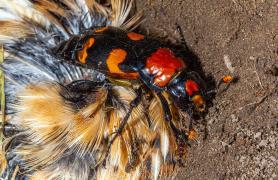Body
…you’d be amazed by this shape-shifting salamander’s complicated life cycle!
Missouri has 19 kinds of salamanders. These amphibians are related to frogs and toads. Most salamanders look like a stumpy cross between a frog and a lizard.
Some kinds of salamanders are known as newts, and Missouri has only one kind — the central newt. It looks kind of like a tadpole.
Until it’s an eft. And then it looks like a lizard.
Central Newt Life Cycle
- The central newt starts and ends its life in the water. As a baby and then again as an adult, the newt has webbed feet and a flattened, finlike tail to help it swim. Most salamanders have longer, more rounded tails and strong toes to help them dig in the dirt.
- When the baby newt starts to become a land-loving red eft, it loses its external gills, leaves its watery cradle, and develops the rough, toxic skin it needs to survive on land. For the next two or three years, the red eft hides in leaf litter, under logs, or in rotten stumps. There, it eats tiny springtails and other small critters. Its red skin sends a warning to any predator that wants to eat it to back off! The red eft’s skin is poisonous enough to kill a mouse but won't hurt humans.
- Eventually, the red eft gets the urge to return to the water. There, its skin softens and develops a slimy, protective coating. It also changes color from red to olive green, but the adult always keeps the bright orange spots of its eft stage. Its tail also becomes flattened and finlike again, and the toes become slightly webbed.
- Adults breathe by rising to the surface for air. During winter, their thin, porous skin absorbs oxygen from the water. When it’s time to start a family, the male and female newts perform an elaborate, swimmy, tale-swishing dance.
- The female lays hundreds of eggs one at a time on submerged plants from May through June. Soon, tiny larvae hatch to feed and grow in the water until August.
- As summer grows hotter, the larval newts transform into efts. Why? Because the adults will eat them if they stay in the water. Singly and in groups, they crawl into the cooler, shady woods. There, they will find a cozy blanket of leaves or a nice rotten stump in which to spend the fall and winter. A few years will pass — until they get the urge to go back to the water and to their lives as newts again.
Red eft phase
As a land-dwelling eft, the central newt looks like a lizard. It has rough skin that is toxic to predators, but it won't hurt you.
Newt phase
Like frogs, toads, and other amphibians, newts need a watery environment for some part of their lives.
Image

Credit
MDC
Right to Use
Image

Credit
MDC
Right to Use
Image

Credit
MDC
Right to Use
Image

Image

Image

Also In This Issue
Media

Body
No other animals on Earth are more successful than these insects.
This Issue's Staff
Bonnie Chasteen
Les Fortenberry
Angie Daly Morfeld
Noppadol Paothong
Marci Porter
Mark Raithel
Laura Scheuler
Matt Seek
David Stonner
Stephanie Thurber
Cliff White
Les Fortenberry
Angie Daly Morfeld
Noppadol Paothong
Marci Porter
Mark Raithel
Laura Scheuler
Matt Seek
David Stonner
Stephanie Thurber
Cliff White






















